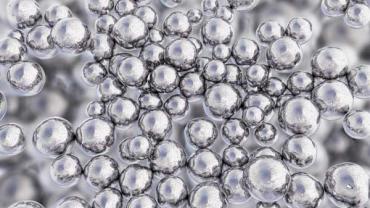
Silver has long been used as an antimicrobial agent (in the form of silver sulfadiazine cream) for second and third-degree burns. Silver has also been used with a cationic polymer to produce bactericidal materials and has been applied to biosensors, drug delivery systems, and medical devices that required antimicrobial properties.
However, the full antimicrobial potential of oral silver has yet to be capitalized upon despite a large amount of promising research that favors the use of silver for addressing contemporary problems in infection control such as multi-drug resistance which is causing a rising number of dangerous hospital and community-acquired infections.
To maximize the antimicrobial efficacy of silver by enhancing absorption and interaction with cell membranes, the size of the metal particle must be reduced to between 1 and 100 nanometers (nm), which classifies the therapeutically effective “silver nanoparticle.” The most therapeutically effective nanoparticles are between 1 and 10nm in diameter. Silver nanoparticles are further distinct based on size, shape, surface functionalization, and stability.
Once absorbed into the bloodstream, silver nanoparticles adhere and accumulate on the bacterial cell wall where they can elicit irreversible damage by creating gaps in the bilayer, increasing permeability and allowing the ability to penetrate the bacterial wall. The smaller the nanoparticle size, the greater the ability to penetrate which also increases the types of bacteria which silver nanoparticles are able to kill. For example, only nanoparticles less then 30nm are effective against, Staphylococcus aureus and Klebsiella pneumoniae. Not only is silver bactericidal by weakening the cell walls of bacteria (much like the mechanism of action in common antibiotics in the penicillin and cephalosporin categories), but once inside, silver nanoparticles can exert is bactericidal activities by damaging protein and DNA through denaturation and blocking transcription/translation. Finally, they are able to release reactive oxygen species (ROS) which enhances the former bactericidal activities.
In some ways, silver nanoparticles may function like traditional antibiotics, but unlike the pharmaceuticals, silver nanoparticles are effective against a broad spectrum of Gram-positive and Gram-negative bacteria (although, it is more effective against Gram-negative bacteria) and unlike traditional antibiotics, are also effective at destroying viruses and fungi. In a study, published in 2019, silver nanoparticles between 10 and 20nm were shown to possess significant antibacterial action (measured by minimum inhibitory concentration and minimum bactericidal concentration) against Bacillus cereus, Listeria monocytogenes, Staphylococcus aureus, Staphylococcus saprophyticus, Escherichia coli, Pseudomonas putida when analyzed by well diffusion assay. Another study published in 2019 showed silver nanoparticles were effective in eradicating Gram-negative Helicobacter pylori which colonizes the gastric epithelium and can be a causative agent in various gastrointestinal diseases including peptic ulcer, gastritis, mucosa-associated lymphoid lymphoma, and adenocarcinoma.
Antibiotic resistance is a global and life-threatening concern in the healthcare industry. Methicillin-resistant S. aureus (MRSA), methicillin-resistant S. epidermidis (MRSE) not only possess antibiotics resistant genes, but also produce biofilms that protect the species from antibiotic penetration. Silver nanoparticles have been shown to prevent the glycocalyx formation necessary for biofilm production and has been able to break through biofilms at concentrations lower than 50 μg/mL.
Another highlight of silver nanoparticles as antibacterial agents is their effectiveness at minimal concentrations. For example, according to one study, the growth of Escherichia coli, Staphylococcus, Providencia, Serratia, and Pseudomonas aeruginosa was inhibited by silver at doses of approximately 1 μg/mL.
The safety of silver nanoparticles is favorable, according to the present research. Although cytotoxicity is noted in some cell lines this action is dose-dependent and toxicity is low and safe for concentrations less than 10 μg/mL. Potential toxicity is related to the overproduction of ROS which may cause oxidative stress in DNA, lipids, and proteins. Toxicity is rarely reported in in vitro and animal experiments while in vivo toxicity data shows no changes in mice health status after intraperitoneal administration.
In an era where bacterial infections are rampant and growing while antibiotic therapies are becoming less effective, alternative antimicrobial agents are vital. Silver nanoparticles are not new agents, but perhaps they have not been given the credit they deserve for addressing this contemporary issue.